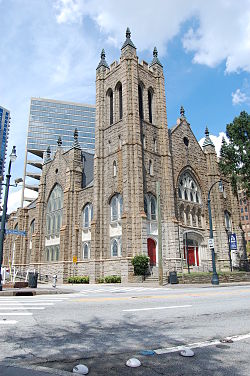This article needs additional citations for verification .(November 2013) |
| Atlanta First United Methodist Church | |
|---|---|
 | |
 | |
| Alternative names | First Methodist Episcopal Church, South |
| General information | |
| Type | Church |
| Location | 360 Peachtree Street NW Atlanta, Georgia |
| Coordinates | 33°45′52″N84°23′09″W / 33.7644°N 84.3858°W |
| Completed | 1903 |
| Design and construction | |
| Architect(s) | Willis Franklin Denny |
First Methodist Episcopal Church, South | |
| Architectural style | Gothic Revival architecture |
| NRHP reference No. | 10001000 |
| Added to NRHP | December 7, 2010 |
The Atlanta First United Methodist Church has existed for more than 160 years and is one of the oldest churches in Atlanta. The current building was constructed in 1903, and the current name was adopted in 1968. The same bell has been used in three buildings since 1850, and it is the only church bell in Atlanta that is known to have survived the American Civil War. It was added to the National Register of Historic Places in 2010. [1]